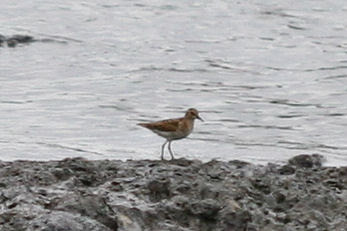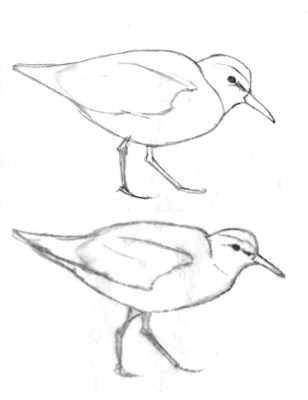Size judgment is one of the constant quandaries of bird identification – critically important but fraught with error. In a recent online discussion about these photos of sandpipers in flight, I was intrigued by the question of how I, and others, “just knew” that these birds were too small to be Knot or Pectoral and must be Least or Semipalmated. There are no reference points in the picture, so the cues for judging size must come from the birds themselves, and proportions of different body parts must hold the key.
 Mystery sandpiper photo by Corey Finger, who relates the whole story here
Mystery sandpiper photo by Corey Finger, who relates the whole story here
Now this photo (above) has been posted and discussed on ID-Frontiers, with no consensus on the identification, but with Least and Sharp-tailed – two species of very different sizes – both getting votes. Again I was intrigued by the question of size judgment. I traced bird outlines from two photographs to compare body size and proportions.
These outlines (below) show two species, different sizes in life but adjusted here so that the wing length and body size are about the same. In this demonstration, the most striking difference is the relative size of the head, making the upper bird look big-headed while the lower bird looks small-headed. There also appears to be a difference in the back end, at least in these two images, but I can cover up that part of the image and still get a strong size impression from just the front half of these two birds.
In this demonstration, the most striking difference is the relative size of the head, making the upper bird look big-headed while the lower bird looks small-headed. There also appears to be a difference in the back end, at least in these two images, but I can cover up that part of the image and still get a strong size impression from just the front half of these two birds.
The upper sketch is traced from a Least Sandpiper photograph, the lower is traced from a Sharp-tailed Sandpiper photograph (both photos in Crossley, Karlson, and O’Brien, The Shorebird Guide).
Does this actually help identify the mystery sandpiper in the photo above? I think so. To me the mystery bird’s head size matches the Least Sandpiper better than the Sharp-tailed. And I think head size is also the key to judging the size of the flying sandpipers in the earlier mystery photos. It may not be definitive, but it’s another point to add to the mix.
This is not to say that larger birds of all species look relatively small-headed (Cooper’s vs. Sharp-shinned Hawk is an obvious exception) but whenever we are judging size in the field or from photos it’s worth pausing to think about what goes into that judgment. Most often it does not involve actual direct comparison of sizes, and I suspect that experienced observers subconsciously rely on body proportions in a lot of cases.


Cool how the birds scale very similarly except for the head. Great idea to trace photos at the same size for comparison! I’ll be re-looking through lots of my pics to see how this works.
Great to see you blogging- I look forward to your notes.
Best- Bill
Judging the size of birds can be hard for sure! This is such a wonderful post and I can’t wait to see what else you continue to write about! Thanks for sharing your knowledge with us!
Ben C.
You commented (and I deleted by mistake):
“This post addresses an issue I came across yesterday (11-Nov-2007). I was birding along the Atlantic Ocean on Staten Island in New York City & spotted a very cooperative Yellowlegs in the spotting scope. I don’t have a lot of experience with shorebirds and there were no other shorebirds to compare it with. Only Brant and gulls were around.
What would you look for to ID a lone Yellowlegs?
All the best.
————————
I’d suggest the new Shorebird Guide referred to in this post as a starting point for learning more about yellowlegs ID. I also have a brief post about identifying them by behavior on my website under Identification notes. It’s always challenging to judge size of yellowlegs and someday when I have time I’d like to try another experiment sketching the proportions of yellowlegs to see how different Greater and Lesser might be.
I volunteer for Beach Watch for Farallones Marine Sanctuary in California,I count all live and dead birds during my survey. Thank you for you information and idea to trace the outline of known birds to improve my ID of birds.
One thing we should not discount during size estimations is that some dynamic features (waves breaking or rippling, branches or trees swaying) have time frequency and shape features that correspond to their *true* size, not apparent size. For waves, if any wind speed perceptions you have are reasonably accurate (ref. the Beaufort Scale), you might be able to estimate how large the waves are given their shape as well as velocity (or frequency and separation distance equivalently). For branches and trees, the same goes. If one thinks the results are worth the time, one could look for waves of similar shape and separation in other photos of known size and see if they tend to be within a specific size range. That might help narrow down the allowed size range for other objects in the photo, including the bird. Even if it is not worth the time to the person raising the question, asking for volunteers on the internet might uncover people who would do the work for free – just for the fun of it.